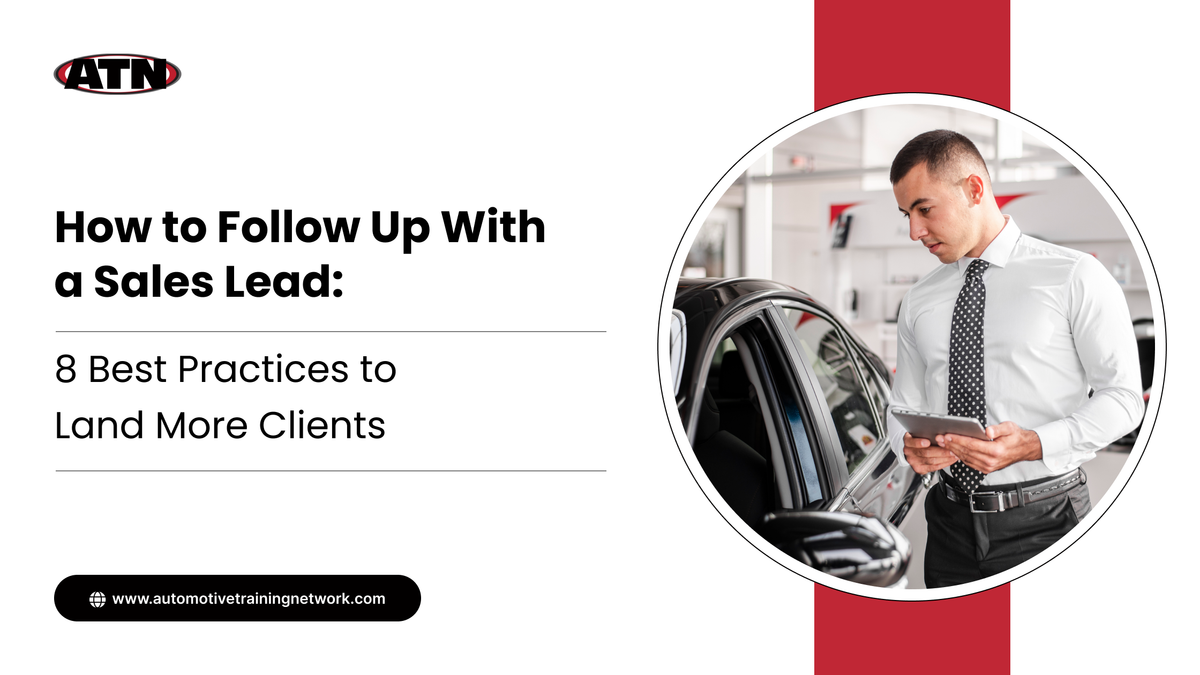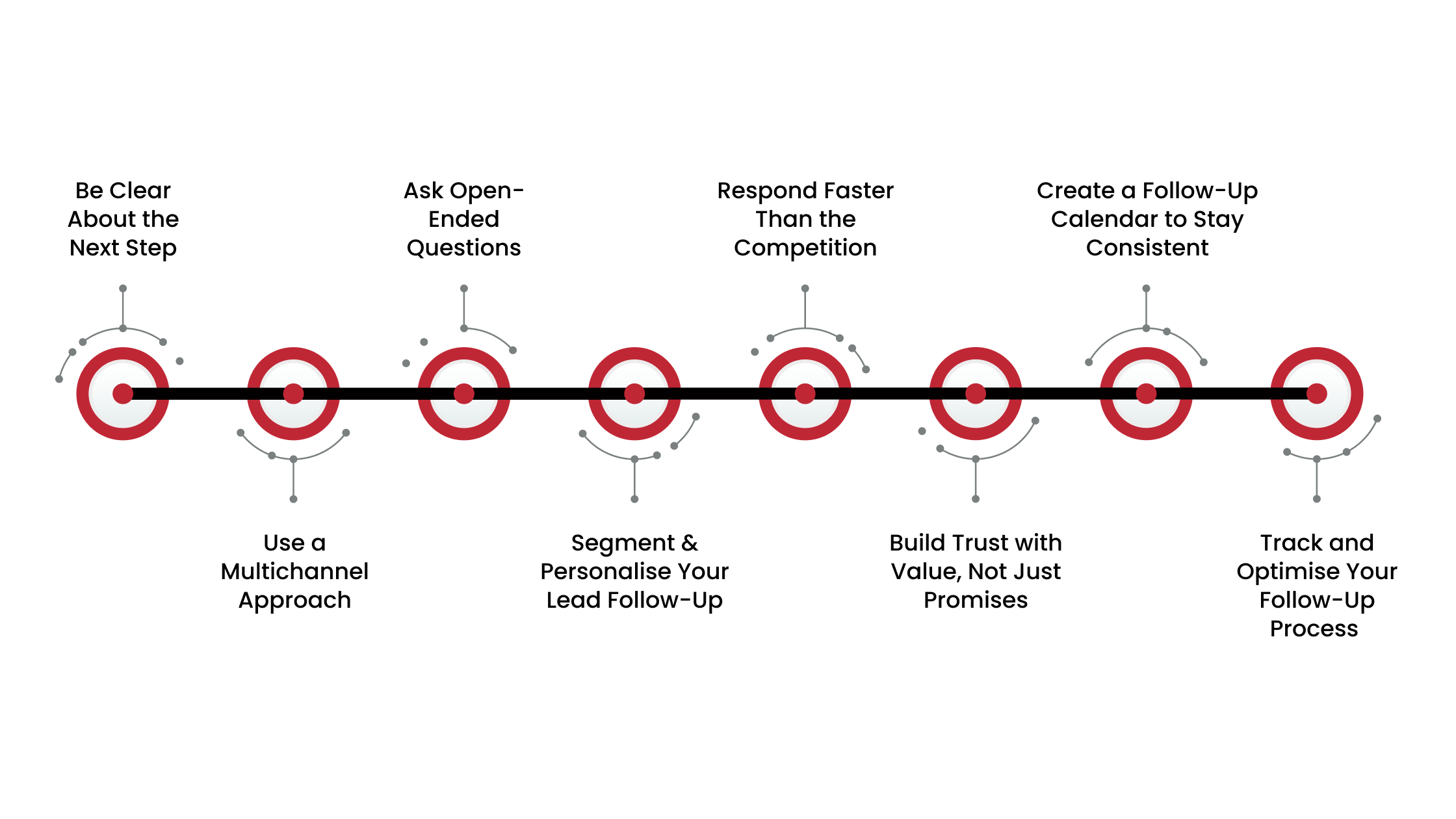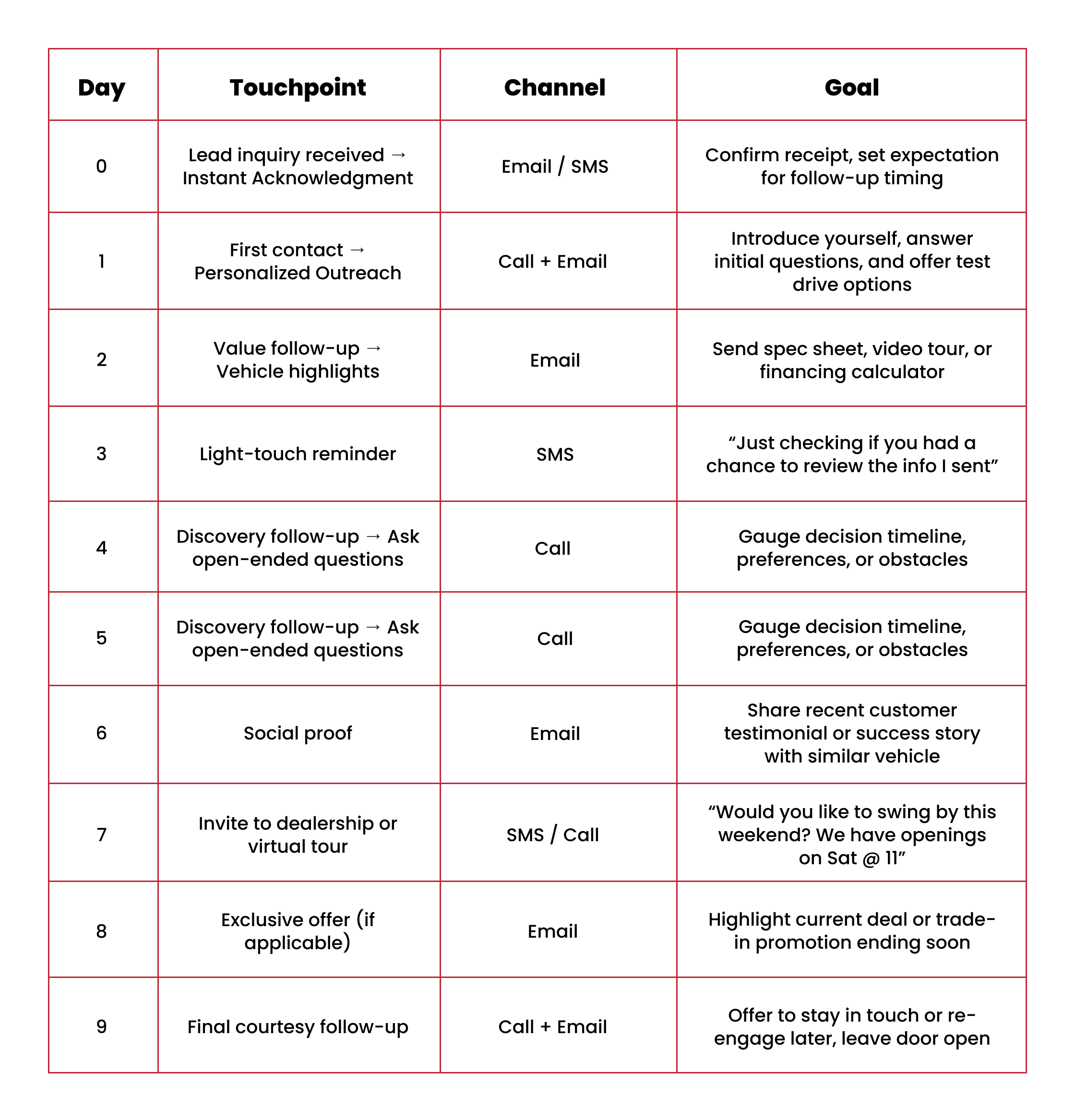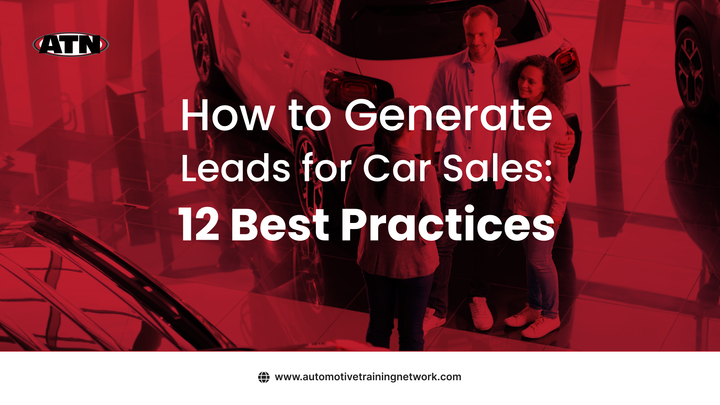How to Follow Up With a Sales Lead: 8 Best Practices to Land More Clients

A potential buyer visits your dealership’s website, fills out a contact form, and requests more information about a specific model. What happens next can determine whether that lead turns into a sale or disappears for good.
According to a study, 78% of customers buy from the company that responds to their inquiry first. In the high-stakes world of automotive sales, that stat alone makes a compelling case that follow-up gives a competitive advantage.
But following up is more than just being quick. Today’s car buyers expect a personalised experience, helpful insights, and communication on their terms. If your dealership’s follow-up strategy feels generic, inconsistent, or overly salesy, you’re likely leaving deals on the table.
In this blog, we’ll walk through eight proven follow-up best practices tailored for dealerships, helping you improve response rates, earn trust, and close more deals. Whether you’re managing new vehicle inquiries, trade-in leads, or service package follow-ups, these strategies will help you stand out and stay top of mind.
8 Best Practices to Land More Clients for Your Dealership

Once a lead comes in, the real work begins. And for dealerships, that follow-up window is critical not just to answer questions, but to build a relationship that turns interest into a signed deal.
Buyers today are comparing options, reading reviews, and expecting tailored communication that matches their pace and preferences. To consistently land more clients, your follow-up process needs to be timely, strategic, and personal.
Here are eight best practices that can help you learn how to follow up with a sales lead and close more sales, without coming across as pushy or falling through the cracks.
1. Be Clear About the Next Step
When it comes to how to follow up with a sales lead, ambiguity is your enemy. After the initial contact, the lead shouldn’t be left wondering, “What now?” Clear direction shows professionalism, keeps momentum going, and reduces the chances of them going cold or shopping elsewhere.
For dealerships, this might mean outlining the following action right after your call or email:
- “I’ll follow up with a vehicle availability update by 3 PM.”
- “Let’s schedule a 15-minute virtual tour for Thursday, does 11 AM work?”
- “You’ll receive a text with a link to your personalised finance options.”
When you set specific expectations, it does two things. First, it builds trust, making it easier for the lead to take action. Most importantly, it positions you as a guide in their buying journey, not just another salesperson.
This clarity is a fundamental part of how to follow up with a sales lead successfully, especially in a competitive dealership environment where response fatigue is genuine. First, impressions can make or break the sale.
2. Use a Multichannel Approach
Relying solely on one method to reach a lead, such as email, can limit your results. Today’s customers are everywhere: checking emails, answering calls, browsing social media, and even texting. That’s why a multichannel approach is one of the most effective strategies for following up with a sales lead.
Start by testing a few methods, such as email, phone, SMS, or social platforms like WhatsApp or Facebook Messenger. Some leads will reply instantly to a text, while others may prefer a formal email. The goal is to determine which channel yields a response and then stick with it for consistency.
For dealership leads, especially, following up with a mix of channels shows professionalism and persistence without being pushy. For example, email a quote, follow up with a call the next day, and then send a quick reminder via SMS if they haven’t responded within 48 hours.
A multichannel strategy ensures that your message doesn’t get buried and helps you stay top-of-mind. Moreover, if you’re still wondering how to follow up with a sales lead, start by being present where your lead prefers to talk.
To master this multichannel outreach, Automotive Training Network offers specialized Virtual Training and In-Dealership Workshops that equip your sales and BDC teams with skills to manage leads across all platforms effectively.
3. Ask Open-Ended Questions
If you’re serious about improving how to follow up with a sales lead, skip the yes-or-no questions. Instead, use open-ended prompts that invite the lead to share more about their needs, hesitations, or timeline. This turns your follow-up from a sales pitch into a meaningful conversation.
For example, instead of asking, “Are you still interested in the SUV?” try, “What factors are most important to you in choosing your next vehicle?” This approach encourages your prospect to open up, giving you insights to tailor your response. It also shows that you’re not just trying to sell a car; you’re trying to understand their unique situation.
In the dealership world, leads are often comparing multiple options. When you ask thoughtful questions, you’re positioning yourself as a trusted advisor rather than just another sales rep. That makes a lasting impression.
Asking questions like “What’s holding you back from moving forward?” or “What would make this decision easier for you?” is a simple but powerful way to uncover objections and offer real solutions.
Mastering how to follow up with a sales lead often comes down to asking the right questions at the right time and then truly listening.
4. Segment & Personalise Your Lead Follow-Up
One-size-fits-all messaging rarely works, especially in dealership sales, where every lead has different needs, budgets, and timelines. If you’re serious about improving your approach to following up with a sales lead, segmentation and personalization are must-haves.
Start by dividing your leads into logical categories, such as new vs. returning customers, high-intent vs. low-intent, car model interests, or budget range. This enables you to craft messaging that resonates directly with their stage in the buying journey. For example, someone browsing luxury SUVs will need a different tone and offer than someone looking for their first used sedan.
Once segmented, personalise your outreach. Use the lead’s name, reference their inquiry, and highlight features or offers relevant to them. Instead of saying, “Let me know if you have questions,” try, “I noticed you’re comparing midsize hybrids. Do you want me to send a quick comparison sheet of the top models?”
When segmenting leads, consider grouping by:
- Vehicle type preference (SUV, sedan, EV, etc.)
- Stage in the buying journey (just browsing, ready to buy, post-test drive)
- Lead source (walk-in, website inquiry, social media ad)
- Budget range or financing needs
- First-time vs. repeat buyer
This approach improves engagement and builds credibility. It shows that you’re paying attention, not just firing off automated messages.
5. Respond Faster Than the Competition
Speed can make or break a deal. Research shows you are seven times more likely to qualify leads when reaching out within an hour, compared to contacting them just an hour later. That’s because buyers are highly engaged immediately after expressing interest and may reach out to multiple dealerships simultaneously.
Quick responses demonstrate professionalism and eagerness to help, building a strong first impression. If a lead reaches out and hears back promptly, they’re far more likely to stay engaged with your dealership rather than moving on.
To ensure your team stays ahead, consider implementing CRM systems that send instant notifications or automate follow-ups. Even having dedicated staff to monitor incoming leads can significantly reduce response times.
Remember, speed can be your significant advantage in turning interest into a sale and leaving the competition behind.
6. Build Trust with Value, Not Just Promises
It’s easy to fall into the trap of focusing solely on closing the deal quickly. However, building genuine trust is far more effective in securing long-term clients. Buyers at dealerships want to feel understood and supported, not just sold to.
Adding real value during follow-ups sets your dealership apart. Instead of repeating generic sales pitches, share helpful resources such as buying guides, maintenance tips, or customer testimonials that address the prospect’s specific needs. Demonstrating knowledge and care helps prospects see you as a reliable advisor, not just a salesperson.
Here’s how to add value in your follow-up communications:
- Provide tailored information based on their vehicle interests or budget
- Share relevant success stories or reviews from satisfied customers
- Offer advice on financing options or trade-in benefits
- Invite prospects to dealership events or test drives
- Answer questions thoroughly and promptly, avoiding pressure tactics
Incorporating these value-driven elements builds rapport and encourages leads to engage further.
7. Create a Follow-Up Calendar to Stay Consistent
Consistency in follow-up efforts can make a significant difference in converting leads into customers. A follow-up calendar helps organize your outreach strategy by scheduling timely touchpoints without overwhelming potential buyers. This systematic approach ensures that no lead falls through the cracks and keeps your dealership at the forefront of your customers’ minds.
By mapping out initial contacts, follow-up calls, emails, and check-ins according to the lead’s behavior or buying stage, you demonstrate professionalism and attentiveness. It also helps your sales team maintain a steady flow of communication, building momentum without appearing pushy.
A well-planned calendar allows you to space communications strategically, respecting the prospect’s time while reinforcing your interest in helping them find the right vehicle. Automating reminders through CRM tools or calendar apps can further streamline the process and boost productivity.
Example of Dealership Follow-Up Calendar (Day 0–9)

Ultimately, creating and sticking to a follow-up calendar improves lead management, nurtures relationships effectively, and increases the chances of closing deals by maintaining engagement throughout the sales journey.
8. Track and Optimise Your Follow-Up Process
Tracking your follow-up efforts is crucial for understanding which strategies are most effective and where improvements are needed. By monitoring primary metrics such as response rates, lead source effectiveness, and conversion percentages, dealerships can gain valuable insights into their sales process.
Use data to identify patterns, for example, which communication channels yield the highest engagement or what times of day produce the best response. This information helps tailor your follow-up approach to meet each lead’s preferences better and increase conversion chances.
Optimizing follow-ups might involve tweaking your messaging, adjusting the timing of outreach, or allocating more resources to the most promising leads. Regularly reviewing performance enables your sales team to refine their tactics, ensuring that follow-ups remain relevant, timely, and impactful.
Automotive Training Network’s Full Dealership Management program supports this continuous improvement by providing a comprehensive framework that integrates sales tracking, team accountability, and performance analysis across all departments. With our expert guidance, your dealership gains the resources and insights needed to identify opportunities, eliminate bottlenecks, and adapt strategies that drive higher conversions.
Investing time in analysing and adapting your follow-up process leads to more innovative sales efforts, improved customer relationships, and ultimately, more closed deals. Tracking progress is not just about numbers, but also about evolving your approach to meet and exceed the expectations of your potential clients consistently.
Accelerate Your Dealership’s Sales Success with ATN Training

Effective follow-up is the lifeblood of converting leads into loyal customers. By being clear about next steps, responding quickly, personalizing communication, and consistently tracking your efforts, your dealership can significantly improve its sales outcomes and customer relationships.
But even the best strategies fall short without well-trained sales teams who understand how to implement these best practices confidently and consistently. Investing in comprehensive employee training equips your staff with the skills to communicate effectively, listen actively, and adapt follow-up techniques based on real-time insights.
At Automotive Training Network (ATN), we’ve been powering dealership success worldwide for over 40 years, offering training and consulting that works. Whether you want to boost your sales team’s skills, master digital lead management, or sharpen your management strategies, ATN has you covered.
- Customized sales training workshops for Sales, BDC, and Internet teams
- Interactive virtual training with live coaching from industry experts
- Intensive 4-day Bootcamps are planned to deliver immediate, measurable results
- In-dealership training tailored to your unique challenges and goals
Provide your team with proven methods and hands-on support that drives real growth. Explore our programs and see why dealerships trust ATN to help them sell more cars, manage leads better, and close deals faster.
Discover more about our training, consulting, and managed store services, and elevate your dealership to the next level.

